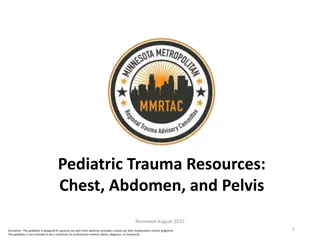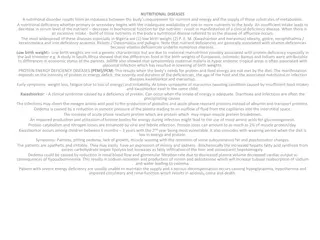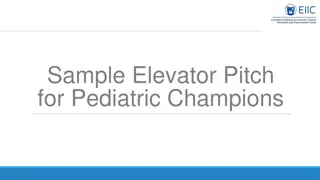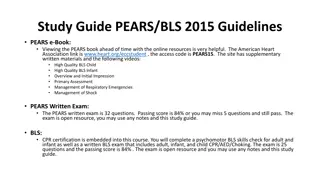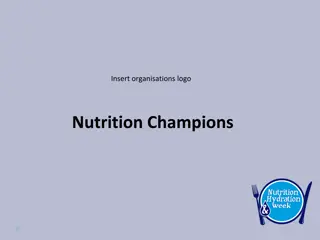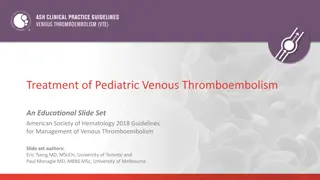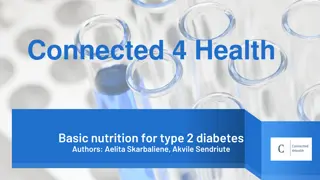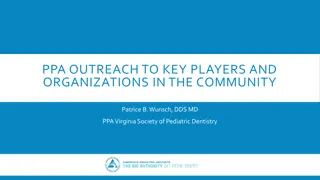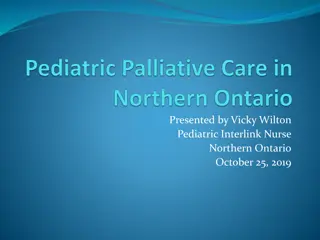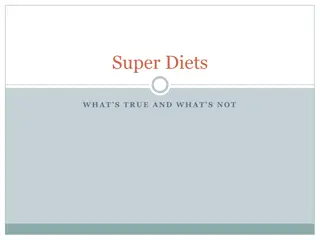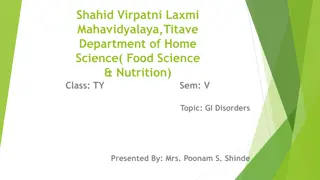Nutritional Consideration and Diet Management in Pediatric Dentistry
This informative content delves into the core areas of nutritional consideration, nutritional assessment of children, and dietary management in pediatric dentistry. Covering topics such as vitamins, minerals, energy for physical activity, and recommended dietary allowances, it offers essential insights for promoting children's health through proper nutrition. With a focus on diet counseling and specific learning objectives, this resource provides a comprehensive overview of the importance of diet in pediatric oral health. Healthcare professionals can enhance their knowledge and strategies to support the well-being of young patients.
Download Presentation

Please find below an Image/Link to download the presentation.
The content on the website is provided AS IS for your information and personal use only. It may not be sold, licensed, or shared on other websites without obtaining consent from the author.If you encounter any issues during the download, it is possible that the publisher has removed the file from their server.
You are allowed to download the files provided on this website for personal or commercial use, subject to the condition that they are used lawfully. All files are the property of their respective owners.
The content on the website is provided AS IS for your information and personal use only. It may not be sold, licensed, or shared on other websites without obtaining consent from the author.
E N D
Presentation Transcript
RUNGTA COLLEGE OF DENTAL SCIENCES & RESEARCH DIET AND NUTRITION DEPARTMENT OF PEDODONTICS AND PREVENTIVE DETISTRY 1
Specific learning Objectives Core areas Domain Nutritional consideration Nutritional assesement of child Nutritional management Diet counselling Introduction Definitions Diet Vitamins Minerals
Category Energy for physical activity Basal metabolism and basal metabolic rate. Specific dynamic action of food. MUST TO KNOW Recommended dietary allowance. [RDA] NEED TO KNOW Food group guides . Food guide pyramid. Dietary goals. DESIRE TO KNOW
contents Introduction Definitions Diet Vitamins Minerals Nutritional consideration Nutritional assesement of child Nutritional management Diet counselling Conclusion
Introduction Inappropriate diet Disease etiology Sedentary lifestyle Cigarette smoking Whatever we eat is a major factor in determining both the quantity and quality of our lives and the basis of this is established early in life. There are many ways in which health professionals can promote the health of their patients. Mc donald, Avery, Dean. Dentistry for the child and adolescent, 8th edition.
Definition (DIET) Total oral intake of a substance that provides nourishment & supply. NIZEL It is the total intake of substance that furnish nourishment & calories to the body. P.M RANDE LPH Defined as combination of food consumed and the nutrients contained there in, having the profound ability to influence cognition, behavior, & ultimate physical growth & development. DCNA Nizel AE. Papas AS.Nutrition in clinical dentistry; 3rd edition
Food Energy Chemical Mechanical Electrical Thermal Measure of energy value of food kilocalories (def) SI joule 1 kcal = 4.18 kJ Nizel AE. Papas AS.Nutrition in clinical dentistry; 3rd edition
Overall Overall energy energy need need Basal Basal metabol metabol - -ism ism Physic Physic- - al al activity activity SDA SDA Basal metabolism : Minimum amount of energy needed to regulate and maintain the involuntary essential life processes viz breathing, blood circulation, pumping of heart, homeostasis, temperature regulation etc. BMR: kcal/m2/hr Nizel AE. Papas AS.Nutrition in clinical dentistry; 3rd edition
Carbohydrate Lipids Proteins Diet Water & electrolytes Vitamins Macro minerals Trace minerals Minerals Nizel AE.Papas AS.Nutrition in clinical dentistry; 3rd edition
carbohydrate Carbohydrates are polyhydroxy aldehydes or ketones. Consist of carbon, hydrogen, & oxygen Emperical formula CnH2On Main source of energy in the body. Currency of the body . Yeild 4 kcal/gm energy. Nizel AE. Papas AS.Nutrition in clinical dentistry; 3rd edition
Functions of carbohydrates: 1. Most abundant dietary source of energy. 2. Brain and RBCs especially. 3. They are structural component of many organisms. 4. Participate in the structure of cell membrane and functions viz cell gowth, adhesion, fertilization. 5. Furnish fibres for peristalsis. 6. Provides energy to oral and intestinal micro- organisms. 7. Facilitate oxidation of fats. 8. Spares proteins. 9. Serve as storage form of energy. Nizel AE. Papas AS.Nutrition in clinical dentistry; 3rd edition
lipids Heterogenous group of organic compounds related to fatty acids. Relatively insoluble in water. Stored in adipocytes. Polar and non-polar groups that confer hydrophobic and hydrophilic properties to the lipids. Yeild 9 kcal/gm energy.
Lipids Simple Fats / oils and Waxes Complex Phospholipids, Glycolipids, Lipoproteins Derived Miscellaneous Linoleic acid Essential fatty acids Linolenic acid Arachidonic acid
Functions of lipids 1. 2. Phospholipids are integral component of cell membrane & regulates permeability. 3. Essential fatty acids are needed for normal growth, cholesterol metabolism and to maintain the integrity and function of cell membrane. 4. Fats act as precursors for synthesis of bile salts, steroids and prostaglandins. 5. Act as carriers and facilitate transport of various vitamins. 6. Maintain body temperature by insulating against cold. 7. Protect vital organs from injury providing cushioning mechanism. Nizel AE. Papas AS.Nutrition in clinical dentistry; 3rd edition Excellent source of energy.
Fats and oral health Indirect evidence reduce caries in human. (Eskimos) Probable mechanism- 1. Oily coating on tooth surface less retention of food. 2. A fatty protective layer on plaque prevent fermentable sugars from being reduced to acids. 3. High concentration of FA may interfer with bacterial growth. 4. Increased dietary fat intake will reduce the dietary intake of carbohydrates necessary for acid production. Nizel AE. Papas AS.Nutrition in clinical dentistry; 3rd edition Ernest newburn; Cariology; 3rd edition
proteins Large complex molecules containing C, H, O and N. Chemically they consist of a no. of amino acids held together by peptide linkages. Yeild 4kcal/gm energy
Protein nutrition in oral health Adequate protein diet during pregnancy needed for proper development of the bones and teeth of the child. After birth, protein is a basic factor in the growth and development of the oral cavity, like every other tissue since proteins serve as building blocks for tissues. Children suffering from protein calorie malnutrition delayed eruption hypoplastic deciduous teeth crowded and rotated teeth. Nizel AE. Papas AS.Nutrition in clinical dentistry; 3rd edition
water The body is mainly composed of water. 60% Water is a vital nutrient crucial to every bodily function and second only to O2 in importance to the body.i It serves as suitable medium for chemical reactions in the body. It serves as a solvent and vehicle to transport inorganic solvents. 80% Nizel AE. Papas AS.Nutrition in clinical dentistry; 3rd edition
water Water plays an integral part in regulating our body temperature when exercising. When we exercise, the body secretes water as sweat. As the sweat evaporates off our skin, it takes heat with it, helping the body to stay cool. We also lose water through breathing. This is why glass mists up when we breathe on it the water vapour in our breath condenses on the cold surface. Nizel AE. Papas AS.Nutrition in clinical dentistry; 3rd edition
Water and oral health Like other soft tissues in the body, oral mucosa has a high water content (70 - 80%) Any systemic factor that produces dehydration or retention of water will cause shrinkage or edema of the oral mucosa. Dehydration decreased salivary flow. Xerostomia - * lack of lubrication of mucosal surface * burning sensation palate and tongue * cracked corners infection * dental caries. * increased plaque formation gingival irritation Nizel AE. Papas AS.Nutrition in clinical dentistry; 3rd edition
VITAMINS Vitamins are organic compounds essential in the diet to promote growth and health maintenance and normal metabolic functioning of the body. Frederick G. Hopkins (1906) Casimir Funk - vitamin Do not contribute directly to the body structure, nor supply energy. They regulate metabolism. Usually act as coenzymes. Nizel AE. Papas AS.Nutrition in clinical dentistry; 3rd edition
Nizel AE. Papas AS.Nutrition in clinical dentistry; 3rd edition
vitamin B COMPLEX 11 different vitamins are discovered. On functional basis, classied as Thiamine, Riboflavin, Pantothenic acid, Niacine Release energy from carbohydrates and fats Folic acid Vit B 12 Catalyse RBCs formation Biotin Vitamin B 6 Protein and A.A. metabolism Choline PABA Vitamin like compound Nizel AE. Papas AS.Nutrition in clinical dentistry; 3rd edition
Edema of legs Cvs disorders Distended neck veins Inadequate thamine in breast milk. Dyspnea, cyanosis, cardiac failure. Wet Dry Beriberi Infantile Possible oral manifestations : Increased sensitivity of oral mucosa Burning tongue Loss of taste. Nizel AE. Papas AS.Nutrition in clinical dentistry; 3rd edition
Smolin & grosvenor. Nutrition science & applications; 2nd edition
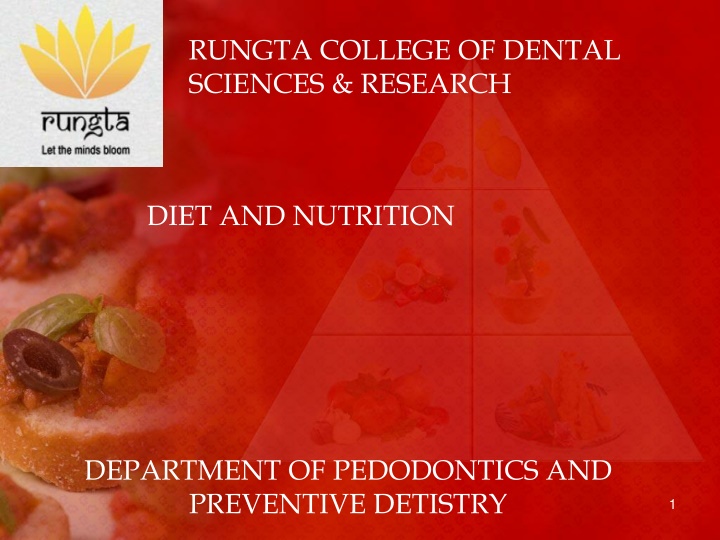

![READ [PDF] Dash diet Cookbook for beginners: 365 days of simple, healthy, low-s](/thumb/2057/read-pdf-dash-diet-cookbook-for-beginners-365-days-of-simple-healthy-low-s.jpg)


